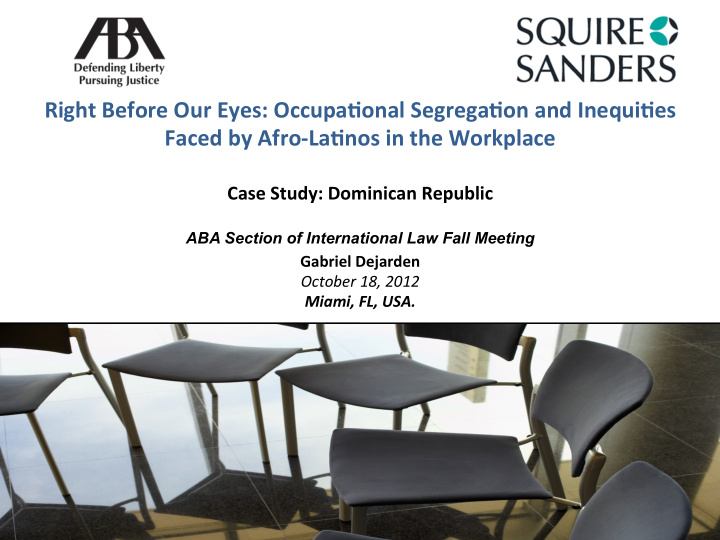



¡ Right ¡Before ¡Our ¡Eyes: ¡Occupa5onal ¡Segrega5on ¡and ¡Inequi5es ¡ ¡ Faced ¡by ¡Afro-‑La5nos ¡in ¡the ¡Workplace ¡ ¡ Case ¡Study: ¡Dominican ¡Republic ¡ ¡ ABA Section of International Law Fall Meeting Gabriel ¡Dejarden ¡ October ¡18, ¡2012 ¡ Miami, ¡FL, ¡USA. ¡ ¡
Topics to be Discussed. 1. Background Information on the Dominican Republic (DR): a) Historical context for this subject. b) Ethnicity. 2. Description of the Problem: a) Entry Barriers. b) Inequities found in the workplace. 3. Regulatory Framework in the DR: a) Applicable Constitutional, Statutory and Treaty Protections. b) Opportunities for Improvement 4. Future Trends
1. Background Information on the Dominican Republic:
a) Historical Context for this Subject. • Roots of inequities faced by Afro-Latinos can be traced back to the system of racial stratification imposed by Spain on its Colonies. • Historical Animosity towards Haiti (a predominately black republic) as a consequence of the wars of independence. • Political Anti-Haitianism: 1) Trujillo era. 2) Dominican Presidential Politics.
b) Ethnicity. • According to the US State Department the population of the Dominican Republic is composed of the following ethnic groups: 1) 75% “ Mixed ” (Caucasian/African/ Indigenous origin) 2) 16% European (Caucasian). 3) 11% African origin.
b) Ethnicity.
b) Ethnicity. • Example of a Dominican ID Card (Cédula):
2. Description of the Problem:
a) Entry Barriers. • A few examples: 1) Requirement to exhibit “ Buena Presencia ” or good looks. 2) Request to include a picture in a submitted job application. 3) “ Suggestion ” to use straight hair in rounds of interviews.
b) Inequities found in the Workplace. • A few examples: 1) Unequal pay. 2) Delayed/Denied promotions. 3) Unfair treatment 4) Exclusion from promotional materials.
3. Regulatory Framework in the DR:
a) Applicable Constitutional, Statutory and Treaty Protections. • Constitutional Protections: 1) Right to Equal Treatment (Art.39). 2) Right to Equal Access to Job Opportunities (Art. 62 numeral 5). 3) Right to Equal Pay (Art. 62 numeral 9). 4) Right to an adequate working environment (Art. 62 numeral 8).
a) Applicable Constitutional, Statutory and Treaty Protections. • Labor Code of the DR: 1) Right to Equal Treatment/No Discrimination on the basis of Race or Color (Principle VII) 2) Right to Equal Pay (Art. 194). • International Conventions: 1) The DR has ratified Treaty 111 of the ILO and the Convention on the Elimination of all Forms of Racial Discrimination.
b) Opportunities for Improvement. • Establishment of a Witness Protection Program. • Creation of Specialized Courts in the South of the DR.
b) Opportunities for Improvement. • Increase fines for non compliance. • Reduction of times to obtain a ruling. • Lack of Enforcement of International Conventions ratified by the DR. • Increase number of labor inspectors. • Increase awareness about the services provided by the Judicial Assistance Department. • Reinforce through training programs the active role that Judges must have in this area.
4. Future Trends:
4. Future Trends: • Short term: Increased awareness of the inequities faced by Afrolatinos in the workplace. • Medium term: Creation of more private initiatives to tackle the problem, such as diversity programs currently in place in many US Law firms. • Medium/Long Term: Legislative, Procedural/ Administrative changes.
Q UESTIONS ?
If you have any questions, please do not hesitate to contact us! gabriel.dejarden@squiresanders.com www.squiresanders.com Thank you for your attention!
Recommend
More recommend